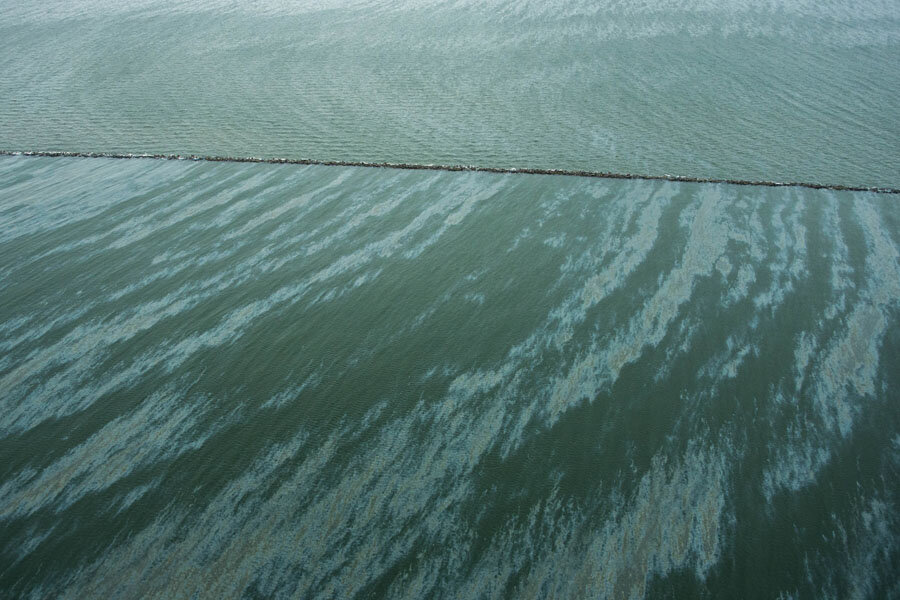Galveston oil spill: No timetable on reopening Texas ship channel
| Texas City, Texas
No timetable has been set to reopen a major U.S. shipping channel after nearly 170,000 gallons of tar-like oil spilled into the Texas waterway, but more help was being called in Monday to contain the spill and protect important shorebird habitat.
A barge carrying about 900,000 gallons of the heavy oil collided with a ship Saturday in the busy Houston Ship Channel, spilling as much as a fifth of its cargo into one of the world's busiest waterways for moving petrochemicals, according to the Coast Guard.
Oil had been detected 12 miles offshore in the Gulf of Mexico by Sunday, and as many as 60 vessels were either waiting to get in or out. The Coast Guard — which called it a "significant spill" — said it expected to deploy more containment booms Monday, with 24 vessels working to skim the oil.
Environmental groups said the spill occurred at an especially sensitive time. The channel in Texas City, about 45 miles southeast of Houston, has important shorebird habitat on both sides, and tens of thousands of wintering birds are still in the area.
"The timing really couldn't be much worse since we're approaching the peak shorebird migration season," said Richard Gibbons, conservation director of the Houston Audubon Society.
He noted that just to the east is the Bolivar Flats Shorebird Sanctuary, which attracts 50,000 to 70,000 shorebirds to shallow mud flats that are perfect foraging habitat.
Fewer than 10 oiled birds had been found and recovered for transfer to a wildlife rehabilitation center as of Sunday afternoon, according to the Coast Guard. The Texas General Land Office has also deployed a bird rehabilitation trailer in the area for quick response.
"This is a significant spill," Capt. Brian Penoyer, commander of the Coast Guard at Houston-Galveston, said. But he said the emptying the remaining oil from the barge on Sunday, a process known as lightering as contents are transferred to other vessels, was an important step and eliminated the risk of additional oil spilling.
More than 380 people — "and we've ordered more," Penoyer said — along with a fleet of oil-retrieving skimmers and other vessels were deploying some 60,000 feet of containment booms around environmentally sensitive areas worked to mitigate the damage.
Some black tar-like globs, along with a dark line of a sticky, oily substance, could be detected along the shoreline of the Texas City dike, a 5-mile-long jetty that juts into Galveston Bay across from a tip of Galveston Island.
"That is the consistency of what the cargo looks like," Jim Guidry, executive vice president of Houston-based Kirby Inland Marine Corp., said when the substance was described to him at a news conference.
Guidry said the company — the nation's largest inland barge company and owner of the barge that spilled the oil — was taking responsibility for the costs.
"We're very concerned. We're focused on cleaning up," he said.
The barge has been moved to a shipyard and is no longer at the scene of the spill, according to a statement Sunday evening from Texas Gov. Rick Perry's office.
Two cruise ships were allowed to travel through the incident area "to minimize inconvenience to the thousands of passengers aboard and limit economic impacts from the spill," according to a statement Sunday evening from the Coast Guard.
The channel, part of the Port of Houston, typically handles as many as 80 vessels daily. But it will remain closed for a third day Monday, and the Coast Guard said there was no timetable on when it may reopen.
If the bottleneck of vessels in the Gulf eases in a day or so, there likely wouldn't be much impact on fuel prices. But a more prolonged backup could push up prices briefly, said Jim Ritterbusch, president of energy consultancy Jim Ritterbusch and Associates in Chicago.
The contents of the torn tank, equal to about 4,000 barrels, were lost or displaced into other vacant areas of the barge. Penoyer said currents, tides and wind were scattering the spill.
"Containment was never a possibility in this case," he said.
The Coast Guard and National Transportation Safety Board are still investigating what happened.
"It will take quite a bit of time, given the complexity of the vessels and a very busy waterway," Penoyer said.
Also closed was the Texas City dike, a popular fishing spot that goes out into the Gulf for a few miles.
Lee Rilat, 58, owns Lee's Bait and Tackle, the last store before the access road to the dike, which was blocked by a police car on a breezy, overcast Sunday. If it weren't for the spill, Rilat's business would be hopping.
"This would be the first spring deal, the first real weekend for fishing," he said.
The spill site is 700 yards offshore from the Texas City dike. A crane and several small boats could be seen at the cleanup site, and dozens of trucks were at a staging area along the beach.
The captain of the 585-foot ship, Summer Wind, reported the spill Saturday afternoon. Six crew members from the tow vessel, which was going from Texas City to Port Bolivar, Texas, were injured, the Coast Guard said.





